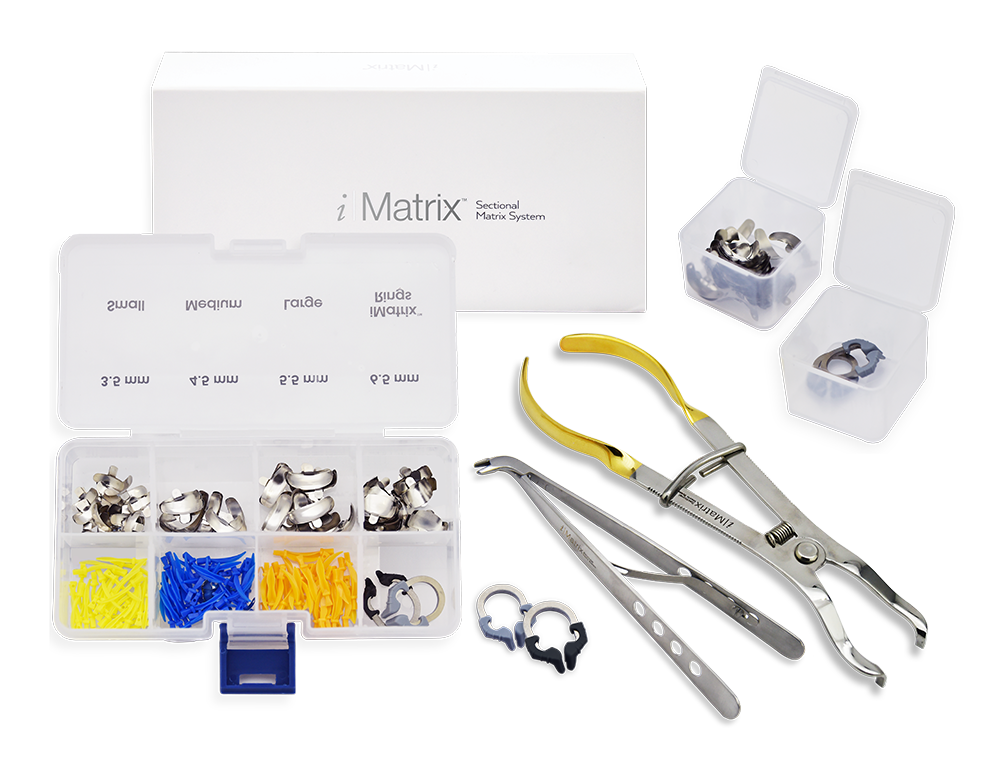We had a chat with Michael Miyasaki, DDS, owner of Miyasaki Dental in Sacramento, California, about how using the iMatrix Sectional Matrix System saves him money without compromising clinical performance.
Q: In your opinion, what are some of the biggest challenges dentists face when using sectional matrix systems?
The first challenge is not using a sectional matrix. I am still surprised by how many doctors are not using a sectional matrix system when placing posterior composite restorations. If I am restoring a tooth surface that does not have an opposing surface, then that is when I may consider a tofflemire-type of matrix, but in that case, the contact is not an issue.
iMatrix™ Sectional Matrix System
The system features ultraretentive NiTi matrix rings that deliver nonslipping contact and reportedly exert ideal tooth separation force. The iMatrix Sectional Matrix System offers the starter kit (with instruments), intro kit (without instruments), and refill kit configurations. The starter kit includes matrix ring placement forceps, tweezers, 2 matrix rings, 3D matrix bands, and interproximal wedges. Features include ideal tooth-separation force delivered by NiTi rings, design that enables easy stacking of multiple retainer rings, guiding rails on tines that match the wedge profiles for better insertion, 2 rings (standard for large teeth and narrow for small teeth); rings that stay put on the teeth and are stackable; and autoclavable retainer rings.
Pac-Dent, Inc
909-839-0888
pac-dent.com
The 2 main reasons I have heard, as I have taught around the world, as to why they use a tofflemire is cost and the clinician being unsure about the technique. Many still use a traditional tofflemire-like matrix, the ones we used when placing amalgam as our filling material. The tofflemire works fine with amalgam because amalgam is dense, truly packable and malleable, and hardens slowly as a self-curing material.
The problems I often hear when a tofflemire matrix is used to place composite are that the contacts are open or light after the occlusion is adjusted and the lack of an anatomical contour interproximally. When placing amalgam, the tofflemire band is pushed against the adjacent tooth to close the interproximal contact by the amalgam placement. There is also no concern about depth of cure, and when the matrix is removed, we still have time to carve it and remove the excess amalgam easily.
Today’s resin materials are not dense enough to truly pack like amalgam, and while doing so, displace the matrix against the adjacent tooth; therefore, the result is we can get open or light contacts. And with composites, we often rely on a light for curing, and they harden quickly once that light energy is applied, making any excess material difficult to remove. And clinicians know that any excess composite means a lot of frustration removing flash around the margins.
Another challenge is seeing around the ring and matrix to place the material, since we are typically conditioning the tooth, placing an adhesive and then multiple layers of composite. If we cannot see the area in which we are working, there is another source of frustration and restorative failure. I often see this when using a sectional matrix that is too tall, so it is important to have a good selection of matrices. The iMatrix system from Pac-Dent, Inc has 2 sizes of rings, narrow and standard, multiple sizes of matrices (3.5, 4.5, 5.5 and 6.5 mm) and wedges (small, medium, and large), and comes in at an exceptionally attractive price, which is about half the price of other systems.
Q: How does the iMatrix’s ring design and matching wedges help you recreate interproximal contacts?
The iMatrix ring provides enough tension to hold the matrix and cause a slight spreading of the adjacent teeth. With some systems, a challenge with the tension is the ring popping off once placed; this is overcome with the undercuts of the iMatrix’s ring tines. This undercut design also helps reduce flash because as with most composite ring systems, the wedge contours the buccal and lingual gingival embrasures and creates a nice seal at the bottom of the prepared box. The iMatrix wedges and rings are designed to fit and work together to accomplish this extraordinarily well. The sequence I use is to place the sectional matrix and then the wedge. The wedge then holds the sectional matrix in place while the ring is positioned and placed. The wedge can be placed after the ring, but I sometimes see the ring move the matrix when the wedge is not placed first. If you then burnish the matrix gently against the adjacent tooth, you will have a nice tight contact and minimal flash.
I also like that there are only 2 ring sizes that I can make work for all the preparations I deal with. The other critical issue is the size of the ring. Many clinicians do not like the space within the ring to be too small, making placement of the filling material difficult, or the ring to be too large, which can make it more difficult to place. The iMatrix’s rings have been designed to meet both requirements, a large enough work area within the ring and yet narrow enough to place easily in the mouth.
The rings have tines that contour the matrix interproximally to minimize flash. The rings are also stackable, meaning multiple rings can be placed over each other, which makes doing multiple interproximal surfaces possible.
The stainless-steel matrix material is thin (0.04 mm) and yet sturdy enough to make placement and removal easy. There is a plier-type tool (I think incorrectly referred to as a pin tweezer) that helps with the placement and removal of the matrices, as many clinicians were frustrated by the other pin tweezer instruments used with other systems. The tool used with the iMatrix system is more robust.
Q: The iMatrix 3D matrix bands are designed with greater curvature for intimate adaptation to the tooth. Has this been your experience? How has it impacted your restorations?
The greater curvature of the 3D matrix bands is something I prefer because they create an anatomical contour, contact, and marginal ridge. This makes my job easier. The curvature also helps reduce flash at all the margins. And because the iMatrix has nice wedges to seal the gingival margin area, it minimizes the flash all around.
These matrix bands are also easy to place and remove. I always advised clinicians to be sure the ring and wedge adapt the matrix to all the preparation’s margins and that the matrix height matches the marginal ridge height so there is minimal finishing that needs to be done.
Q: Can you describe the spring strength and separation force of the iMatrix’s NiTi rings? Do these features adequately seal the prep walls?
The NiTi material of the rings has the perfect force, which makes placement of the rings easy, yet contours the matrix and provides a good separation force so that once removed, the interproximal contacts are perfectly shaped and tight. Over time, if the user feels the tension has decreased with use, the rings can be retensioned using the forceps.
Q: Can you summarize a recent restoration for which using iMatrix led to a highly successful outcome?
We have done many restorations on molars and bicuspids to run the iMatrix through the paces. After the Class II preparation was finished, I selected a matrix that would seal the gingival floor of my preparation and extend to, but not above, the marginal ridge. This was placed with the plier-like placement tool, and then I placed the small wedge to stabilize the matrix.
The standard ring was placed over the wedge so that it contoured the matrix against the axial margins. I then burnished the matrix against the adjacent tooth. At this point I always look into the preparation to be sure all the finish lines are sealed by the matrix.
We went through the placement steps of our composite and once cured, removed the matrix system components without much more to do. Flossing showed we have a nice contact without any gingival overhangs, and the marginal ridge was at the correct height. After a quick check of the occlusion and polishing of the composite, we were done.
The iMatrix Sectional Matrix System features ultraretentive NiTi matrix rings that deliver nonslipping contact and exert the ideal tooth separation force. The iMatrix Sectional Matrix System offers the starter kit (with instruments), intro kit (without instruments for those who already have Palodent Plus or Garrison Dental’s instruments), and refill kit configurations
The iMatrix system makes placing posterior composite restorations predictable and efficient. It is a system that works without compromise. I appreciate a system that allows me to save money without compromising any clinical performance, and this makes the iMatrix an exceptionally excellent value [and a system] that clinicians should consider.

